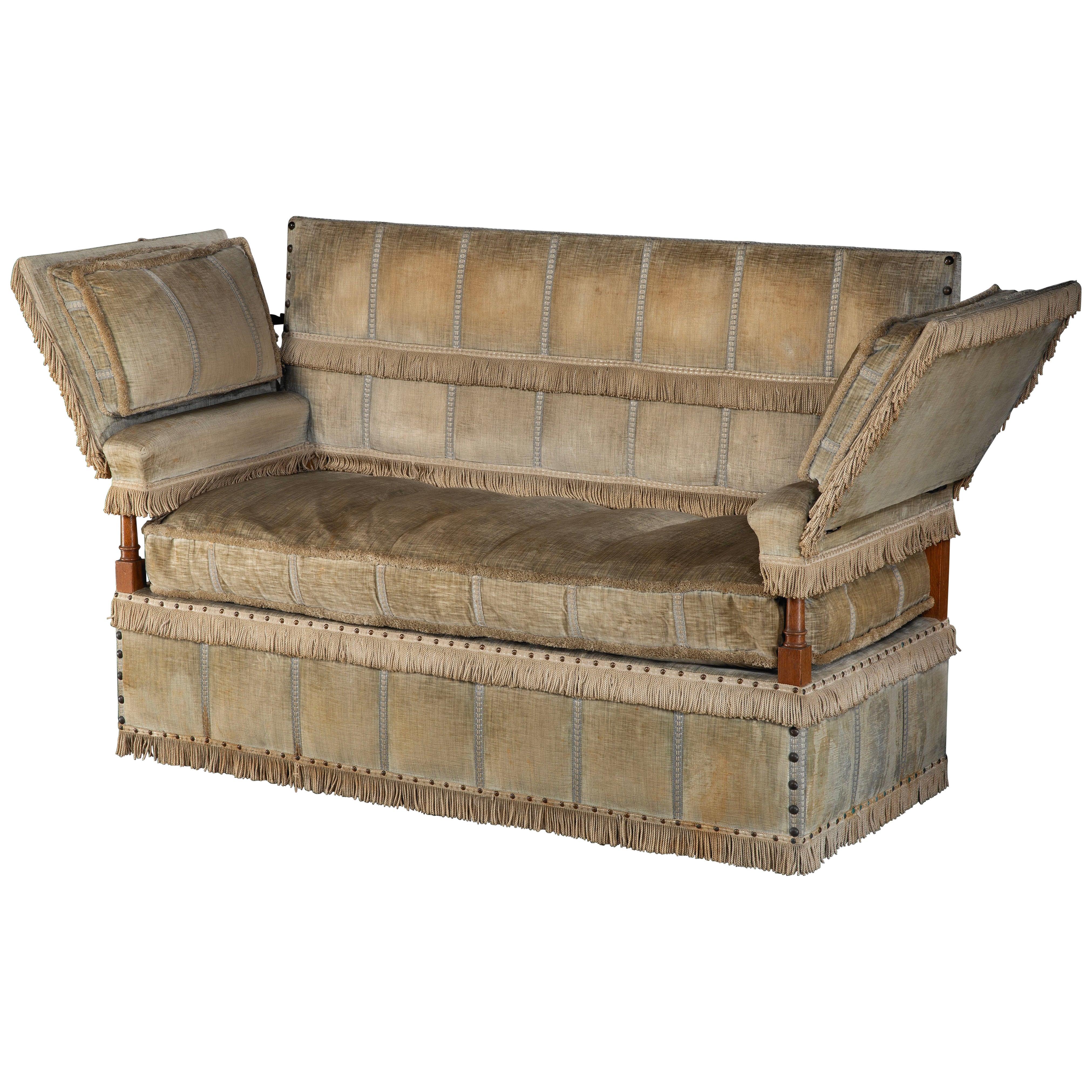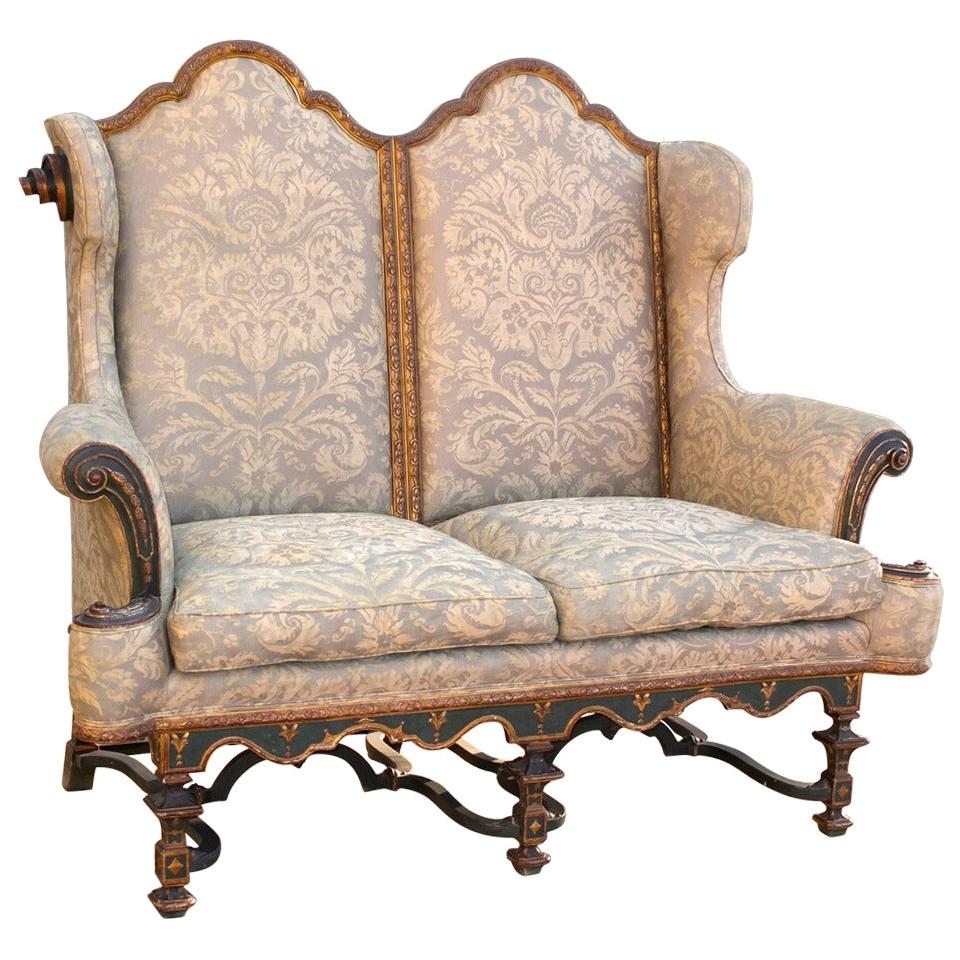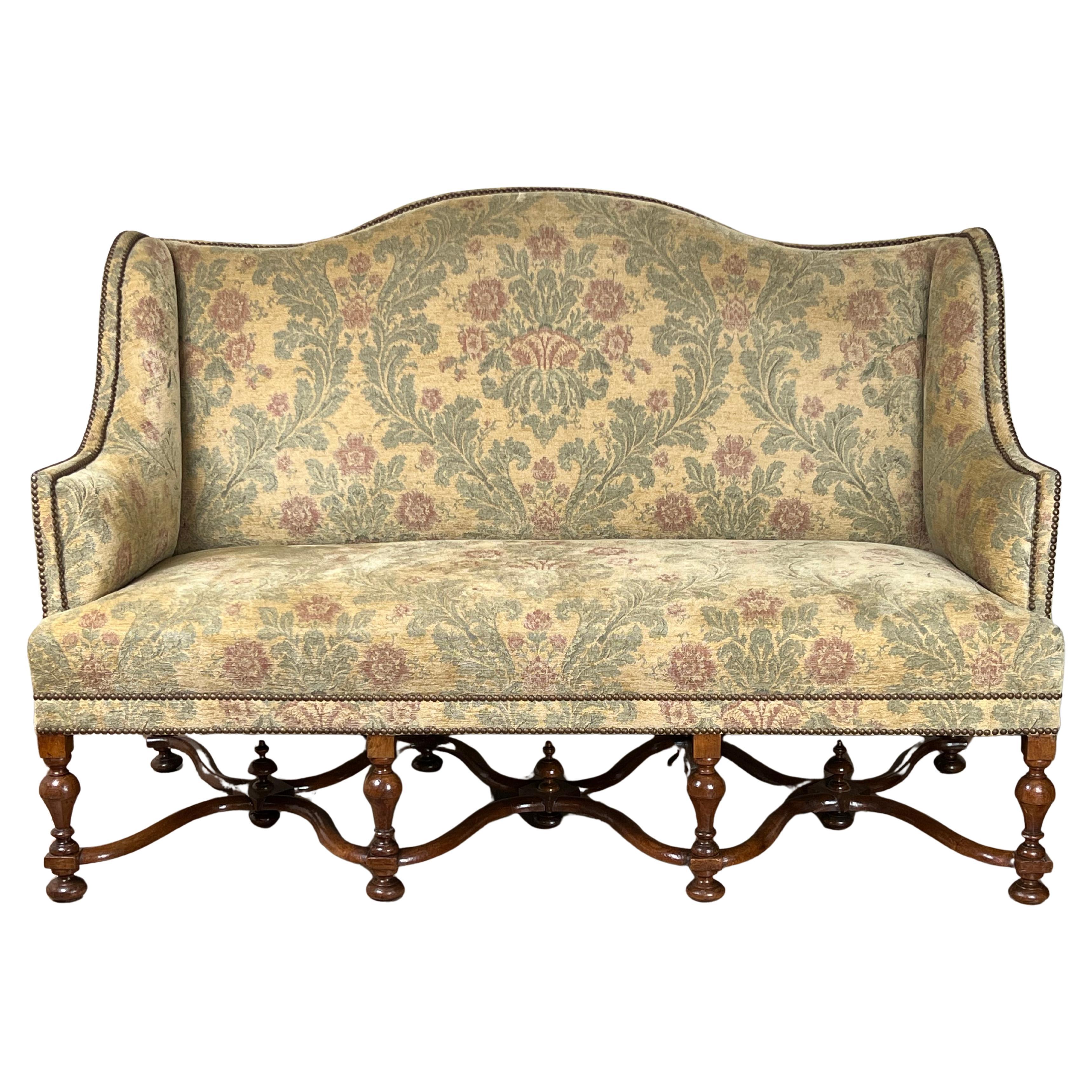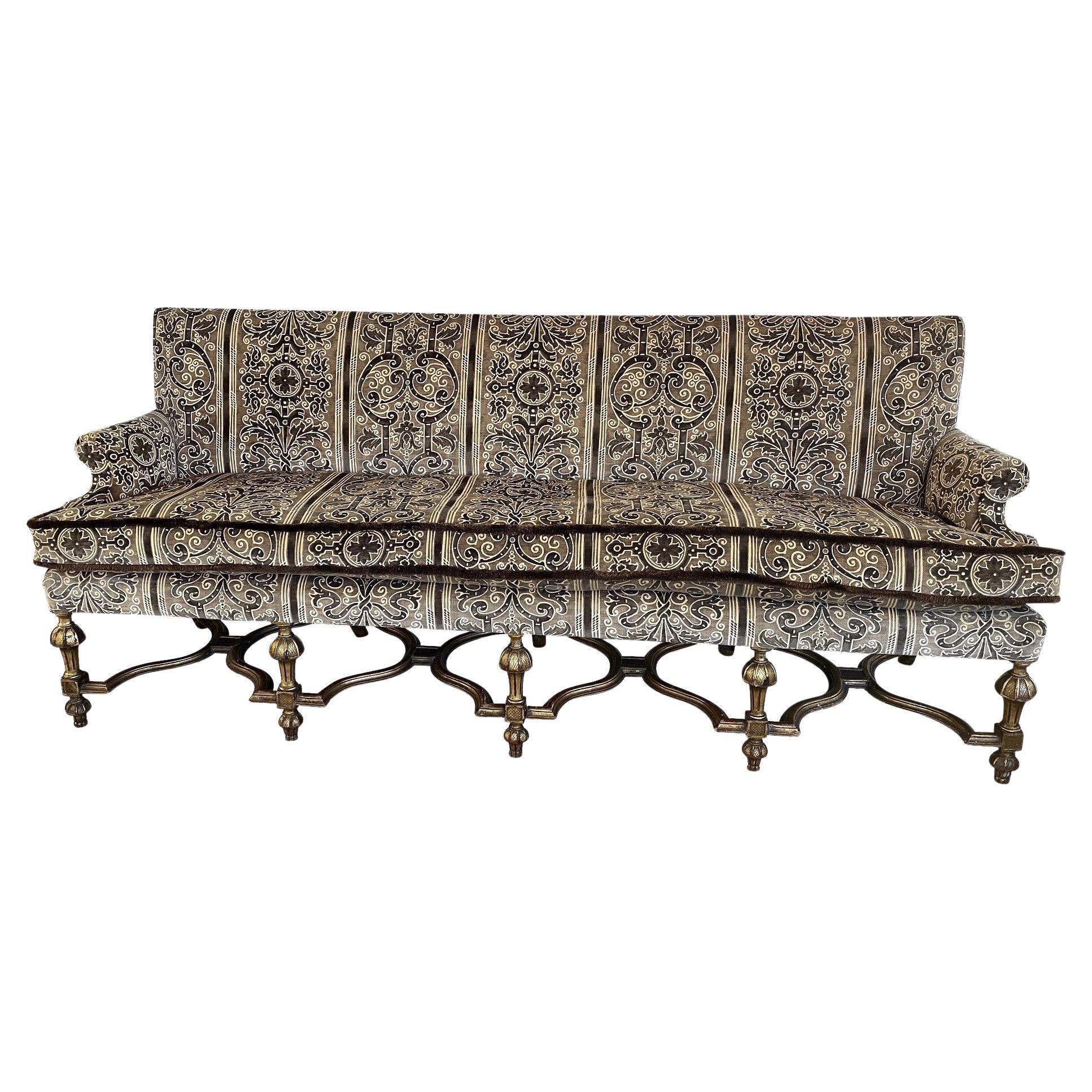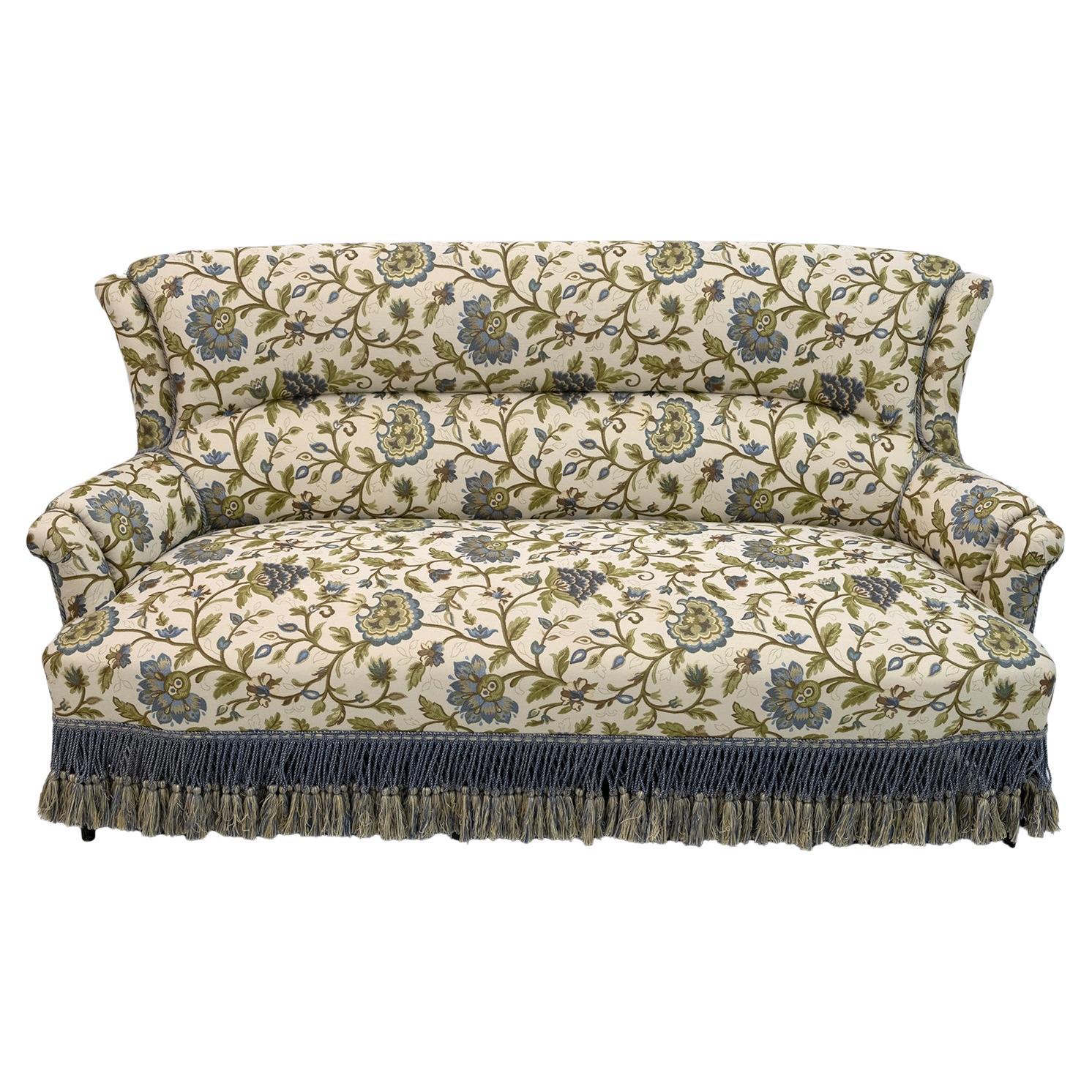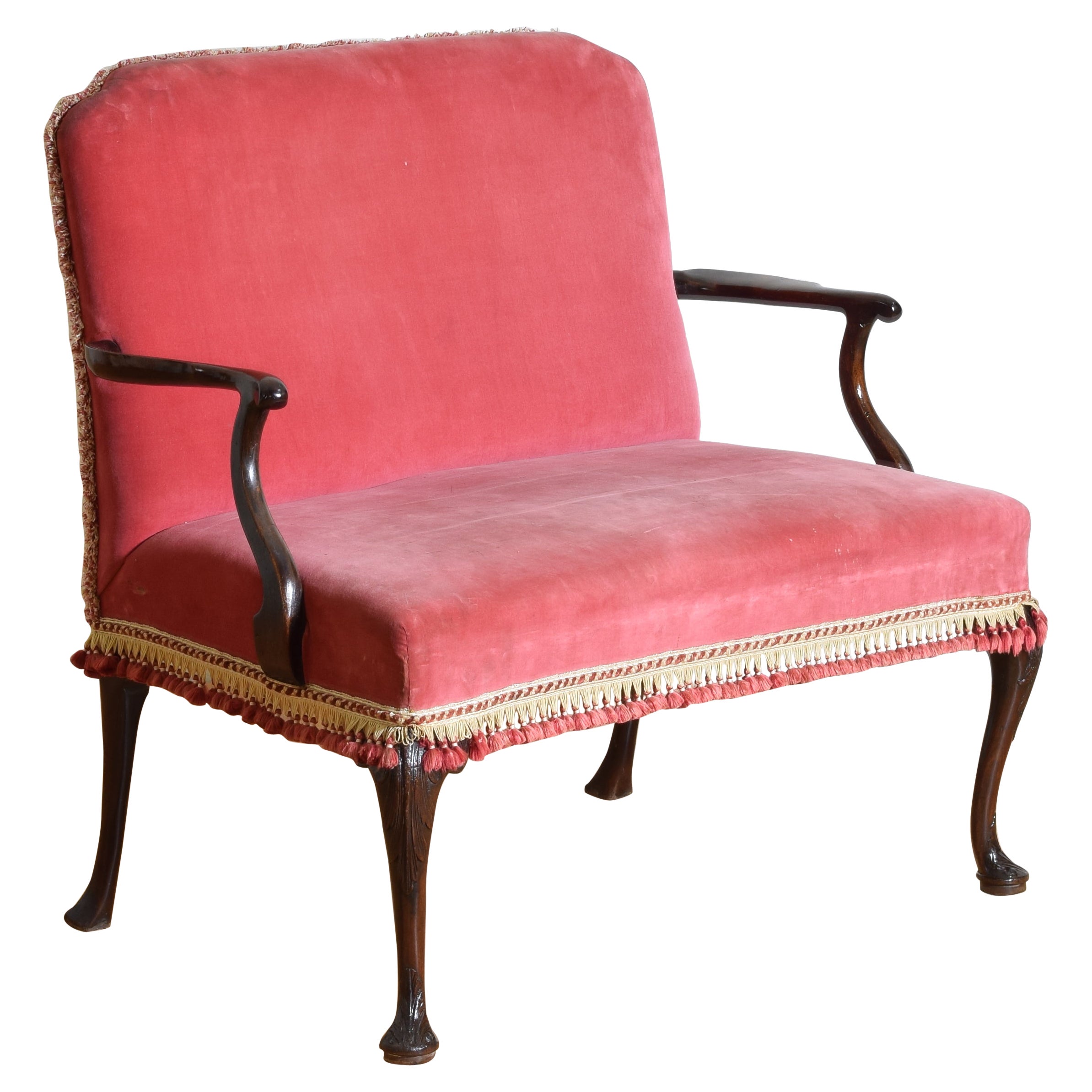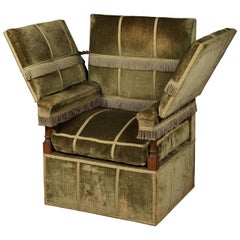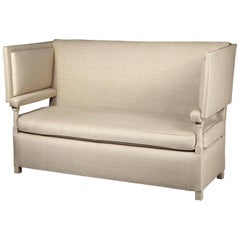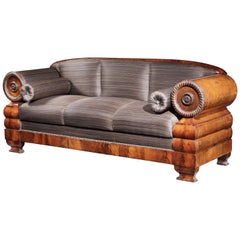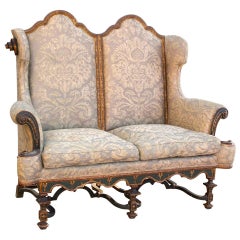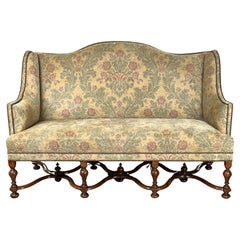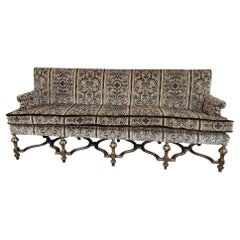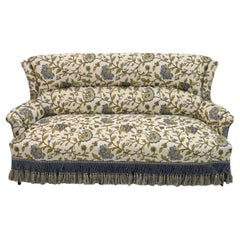Items Similar to Knole Settee, Cowdray Park, English, Lengyon & Co, olive velvet, tapestry
Want more images or videos?
Request additional images or videos from the seller
1 of 12
Knole Settee, Cowdray Park, English, Lengyon & Co, olive velvet, tapestry
$34,967.62
£25,000
€29,855.46
CA$47,835.01
A$53,528.72
CHF 27,950.18
MX$658,079.88
NOK 352,623.77
SEK 331,817.23
DKK 222,744.64
Shipping
Retrieving quote...The 1stDibs Promise:
Authenticity Guarantee,
Money-Back Guarantee,
24-Hour Cancellation
About the Item
- EXCEPTIONALLY, RARE, MUSEUM QUALITY PIECE, THE COWDRAY PARK KNOLE SETTEE, INVENTORY NUMBER D2029
- Supplied by Lengyon & Co, the pre-eminent maker, to Viscount Cowdray, Cowdray Park, Sussex. Part of the furnishings in the Great Hall at Cowdray Park, bearing a brass disc with the inventory number D2029
- In the late-19th century this model of settee was revived, particularly for Great Halls, bedrooms and galleries in large country houses for its early aesthetic, comfort and draught exclusion from the high backs.
- It retains the original iron ratchets so the wings can be lowered to different heights.
- The 17th century Brussels tapestry panel is finely woven with a central cartouche and floral sprays and, unusually, retains its blue colouring
- The settee has been re-upholstered in a sage green velvet as the original was threadbare when I acquired it.
- The passmenterie has been colour-dyed to match the tones of the velvet and the tapestry and hand-made.
- It is extremely comfortable, you sink back into it.
- It is sturdy and suitable for everyday use as the velvet has 100 years of life in it and the tapestry has been cleaned, conserved and stablised
This is an early 20th century interpretation of the infamous, sumptuously, upholstered, 17th century, couch with hinged arm rests, found at Knole Park, Sevenoaks, Kent, the ancestral seat of the Sackvilles made by the most eminent upholsterer of the early 20th century. The original couch served the dual purpose of bed and settee, and is one of the earliest examples of English, upholstered, seat furniture. This is a particularly fine example, with an exceptional provenance.
The straight, padded back incorporating a piece of mid-17th century tapestry depicting a characteristic baroque cartouche with cornucopia containing tulips surrounded by a profusion of floral sprays and bunches of grapes. The adjustable padded wings joined to the arms with ratched iron hinges and attached to the back. The arms are supported by oak turned uprights, one bearing the Cowdray Park inventory number D2029 on a brass disc. The seat with a large loose cushion. Standing on original castors. English, second half of the 19th century. The original silk damask was threadbare and the settee has been re-upholstered in a grey/green velvet with custom made passmenterie.
Closed Length 176 cm. 69 ¼ in, Fully Extended Length 254. 100 in., Depth 69 cm. 27 in.,
Height 111 cm. 43 ½ in. seat height 54 cm. 21 ¼ in.
During the late-16th/early 17th century a new form of day-bed was introduced to match the contemporary upholstered ‘X’ chairs and stools. They were padded and upholstered throughout and the ends were let down on a toothed steel ratchet to enable the occupant to repose at full length. They were generally destroyed when the coverings had worn out at the woodwork was of little value. One survives at Knole Park, illustrated above.
Similar couches were plentiful in France under Louis XIII and can be seen in Abraham Bosse’s engravings of domestic interiors but they were only found at Court and the houses of great noblemen in this country. When the contents of the Royal Palaces were dispersed after Charles I’s execution a number of couches were included in the sale.
Francis Lenyon, Lenyon & Co., Lenyon & Morant
Born in England in 1877, Lenygon was trained as a cabinetmaker and studied at the South Kensington Museum in London. By 1900, he found work with Art Workshops, Ltd., and soon after with Charles Duveen, son of Sir Joseph Duveen. Employed by C.J. Charles for several years, Lenygon became well-known as cabinetmaker to England's aristocracy. He opened his own firm, Lenygon & Co., in 1904, and in 1912 merged with Morant & Co., to become Lenygon & Morant, holding royal warrants under four successive British kings.
In 1910, Lenygon made his first visit to the United States to supervise the interior decoration of Whitlaw Reid, and soon opened a New York branch of his firm. As in England, Lenygon's American clients were wealthy and sophisticated and relied on Lenygon to furnish authentic and reproduction interiors in period styles. In the 1930s, Lenygon was hired by Nelson Rockfeller to serve as a major consultant to the reconstruction of Colonial Williamsburg in Virginia, and selected all the furnishings for the Governor's Palace there.
Lenygon was widely known for his expertise in 17th- and 18th-century British furniture and interiors and lectured widely on the subjects. He served as president of the American Institute of Decorators and the Art and Antiques Dealers League of America. He was also a Fellow of the Royal Society of Arts and the North British Academy. Lenygon died in New York City in 1943. He was survived by his second wife, Jeanette Becker Lennygon, whom he married in 1926. Jeannette was also a well-respected interior designer, best known for her redecoration of several rooms in the White House during John F. Kennedy's presidency and for the interior redesign of Gracie Mansion for New York mayor John Lindsay. She was also a founding member of the American Institute of Interior Designers. Jeannette died in Evanston, Illinois, in 1977.
Cowdray Park
'Cowdray. I settled the terms of purchase yesterday. Price £340,000. It is a big venture, but even if the oil does not prosper and we do not become more heavily involved than our present commitment... we cannot, I think, be accused of undue rashness in buying the property.'
Pearson’s purchase included the splendid ruins of the great Tudor house, as well as its Victorian successor, which had been built by the Earls of Egmont: Pearson intended to replace this, referring to his investment in oil in Mexico as 'the trade that I am in - in my dreams - hoping will build the new Cowdray Castle and finish it with one year's earnings'. War, and perhaps wiser counsels, would prevail and the Cowdrays contented themselves with altering the Victorian house.
A 'princely estate' by Pearson's own admission, Cowdray is steeped in history. Dating from the early 16th century, Cowdray was purchased from Sir David Owen by Sir William Fitzwilliam, a favourite of King Henry VIII, who obtained licence in 1532 to crenellate walls and towers on the site that had been hitherto known as La Coudreye. In 1542 it passed to Sir William's half-brother, Anthony Mary Browne, whose first son would become 1st Viscount Montague. King Henry VIII visited Cowdray on a number of occasions, as did Edward VI in 1552 (when he is reported to have complained on the food being too rich) - whilst Queen Elizabeth I's visit on her Royal Progress of 1591 was later depicted in an oil by James Pryde.
Arguably one of the finest Tudor houses in England, it was devastated by fire in 1793. Little is known of the original interior at Cowdray, save for some 18th century watercolours by a Samuel Hieronymous Grimm, which document the Buck Hall.
The Cowdrays as Collectors
Cowdray Park House was built in 1874 and has been the family seat since 1909 when it was bought by Sir Weetman Dickinson Pearson, who became the 1st Viscount Cowdray. The first Viscount Cowdray and his wife were among the most prolific and discerning British collectors of the early 20th Century. The couple and their son, Weetman Harold Miller Pearson, the second Viscount Cowdray, bought most of the antiques and artworks in the Collection.
Pearson’s purchase included the splendid ruins of the great Tudor house, as well as its Victorian successor, which had been built by the Earls of Egmont: Pearson intended to replace this, referring to his investment in oil in Mexico as 'the trade that I am in - in my dreams - hoping will build the new Cowdray Castle and finish it with one year's earnings'. War, and perhaps wiser counsels, would prevail and the Cowdrays contented themselves with altering the Victorian house.
A 'princely estate' by Pearson's own admission, Cowdray is steeped in history. Dating from the early 16th century, Cowdray was purchased from Sir David Owen by Sir William Fitzwilliam, a favourite of King Henry VIII, who obtained licence in 1532 to crenellate walls and towers on the site that had been hitherto known as La Coudreye. In 1542 it passed to Sir William's half-brother, Anthony Mary Browne, whose first son would become 1st Viscount Montague. King Henry VIII visited Cowdray on a number of occasions, as did Edward VI in 1552 (when he is reported to have complained on the food being too rich) - whilst Queen Elizabeth I's visit on her Royal Progress of 1591 was later depicted in an oil by James Pryde.
Arguably one of the finest Tudor houses in England, it was devastated by fire in 1793. Little is known of the original interior at Cowdray, save for some 18th century watercolours by a Samuel Hieronymous Grimm, which document the Buck Hall.
The Cowdrays as Collectors
Cowdray Park House was built in 1874 and has been the family seat since 1909 when it was bought by Sir Weetman Dickinson Pearson, who became the 1st Viscount Cowdray. The first Viscount Cowdray and his wife were among the most prolific and discerning British collectors of the early 20th Century. The couple and their son, Weetman Harold Miller Pearson, the second Viscount Cowdray, bought most of the antiques and artworks in the Collection.
The family started out with a small company in Bradford, which became one of the most successful business empires of the 20th Century and one of the largest construction companies in the world. The 1st Viscount Cowdray won a contract to drain Mexico City in 1889, and went on to develop vast oil fields in Mexico, accruing extraordinary wealth.
Provenance: The first Viscount Cowdray, Weetman Pearson, Cowdray Park.
Literature: 17th Century Interiors & Decoration (Peter Thornton) ill 150 depicts the couch at Knole
- Creator:LENGYON & CO (Maker)
- Dimensions:Height: 43.71 in (111 cm)Width: 69.3 in (176 cm)Depth: 27.17 in (69 cm)
- Style:Charles II (In the Style Of)
- Materials and Techniques:
- Place of Origin:
- Period:
- Date of Manufacture:1900-1910
- Condition:Reupholstered. Wear consistent with age and use. See above.
- Seller Location:BUNGAY, GB
- Reference Number:1stDibs: LU3867315798752
About the Seller
5.0
Vetted Professional Seller
Every seller passes strict standards for authenticity and reliability
Established in 1985
1stDibs seller since 2018
97 sales on 1stDibs
Typical response time: 9 hours
- ShippingRetrieving quote...Shipping from: BUNGAY, United Kingdom
- Return Policy
Authenticity Guarantee
In the unlikely event there’s an issue with an item’s authenticity, contact us within 1 year for a full refund. DetailsMoney-Back Guarantee
If your item is not as described, is damaged in transit, or does not arrive, contact us within 7 days for a full refund. Details24-Hour Cancellation
You have a 24-hour grace period in which to reconsider your purchase, with no questions asked.Vetted Professional Sellers
Our world-class sellers must adhere to strict standards for service and quality, maintaining the integrity of our listings.Price-Match Guarantee
If you find that a seller listed the same item for a lower price elsewhere, we’ll match it.Trusted Global Delivery
Our best-in-class carrier network provides specialized shipping options worldwide, including custom delivery.More From This Seller
View AllSettee Sofa Couch Knole Velvet Strie Olive 3-seater H44" Adjustable L67-101"
Located in BUNGAY, SUFFOLK
- This is an early 20th century interpretation of the infamous, sumptuously, upholstered, 17th century, couch with hinged arm rests, found at Knole Park, Sevenoaks, Kent, the ancestral seat of the Sackvilles made by the most eminent upholsterer of the early 20th century.
- The original couch served the Dual purpose of bed and settee, and is one of the earliest examples of English, upholstered, seat furniture. In the late-19th century this model of settee was revived, particularly for Great Halls, bedrooms and galleries in large country houses for its early aesthetic, comfort and draught exclusion from the high backs. - These settees are extremely comfortable as well as injecting period atmosphere into the interior. They sit equally well within contemporary and historical interiors and jutapose with contemporary and modern pieces and art.
- This is a particularly fine example, with a Grade II* listed Jacobean manor house provenance and almost certainly made by Morant & Co. It retains the original iron ratchets so the wings can be lowered to different heights.
The inside and outside back, wings, seat and cushion are upholstered in a strie velvet and trimmed in the traditional manner with matching braid and fringe and studs. The strie velvet probably dates from the 1950's, as there is significant fading from the original pale green/aqua to a pale olive/old white. The adjustable padded wings are joined to the arms with original ratched iron hinges which are attached to the back. The arms are supported by oak turned uprights. The seat has a large loose cushion. Standing on original castors. English, circa 1900.
During the late 16th-early 17th century a new form of daybed was introduced to match the contemporary upholstered 'X' chairs and stools. They were padded and upholstered throughout and the ends were let down on a toothed steel ratchet to enable the occupant to repose at full length. They were generally destroyed when the coverings had worn out at the woodwork was of little value. Similar couches were plentiful in France under Louis XIII and can be seen in Abraham Bosse's engravings of domestic interiors but they were only found at court and the houses of great noblemen in this country. When the contents of the Royal Palaces were dispersed after Charles I's execution a number of couches were included in the sale.
PROVENANCE : Barrow Court, a Grade II* listed Jacobean manor house with origins dating back to the 13th century.
MORANT & CO Upholsterers, Decorators. 91 New Bond St., London. With Royal Coat of Arms, dated 1825, 1831, 1837 and 1890, founded 1790.
The dictionary of English furniture makers 1660-1840, published by the Furniture History Society informs that Morant Snr. was a maker of carved and gilded frames from early in the reign of George IVth, and his trade card describes the company as 'Ornamental Painter and Paper Hanging Manufacturer to their Royal Highnesses'. Work was executed for Sir Thomas Lawrence, Sir Robert Peel...
Category
Antique Early 1900s English Baroque Revival Settees
Materials
Velvet
Knole Armchair, English, Morant & Co, Green Strie Velvet
By Morant & Co.
Located in BUNGAY, SUFFOLK
This is an early 20th century interpretation of an armchair inspired by the infamous, sumptuously, upholstered, 17th century, couch with hinged arm rests, found at Knole Park, Sevenoaks, Kent, the ancestral seat of the Sackvilles made by the most eminent upholsterer of the early 20th century. The original couch served the dual purpose of bed and settee, and is one of the earliest examples of English, upholstered, seat furniture. This is a particularly fine example, with a Morant & Co provenance. A matching 3-settee is also available
The inside and outside back, wings, seat and cushion are upholstered in green strie velvet and trimmed in the traditional manner with matching braid and fringe. The strie velvet could be original, if this armchair has been lightly used, as there is significant fading from the original bright green. The adjustable padded wings are joined to the arms with original ratched iron hinges which are attached to the back. The arms are supported by oak turned uprights. The seat has a large loose cushion. Standing on original castors. English, circa 1900.
Bearing the fabric retail label of Morant & Co Upholsterers, Decorators. 91 New Bond St., London. with Royal Coat of Arms, dated 1825, 1831, 1837 & 1890, founded 1790.
During the late 16th-early 17th century a new form of day-bed was introduced to match the contemporary upholstered ‘X’ chairs and stools. They were padded and upholstered throughout and the ends were let down on a toothed steel ratchet to enable the occupant to repose at full length. They were generally destroyed when the coverings had worn out at the woodwork was of little value. Similar couches were plentiful in France under Louis XIII and can be seen in Abraham Bosse’s engravings of domestic interiors but they were only found at Court and the houses of great noblemen in this country. When the contents of the Royal Palaces were dispersed after Charles I’s execution a number of couches were included in the sale.
Morant & Co (fl.1885-1915)
The dictionary of English furniture makers 1660-1840, published by the Furniture History Society informs that Morant Snr. was a maker of carved and gilded frames from early in the reign of George IVth, and his trade card describes the company as ‘Ornamental Painter and Paper Hanging Manufacturer to their Royal Highnesses’. Work was executed for Sir Thomas Lawrence, Sir Robert Peel...
Category
Antique Early 1900s English Baroque Revival Armchairs
Materials
Velvet
Knole Settee, 19 Century, English Baroque, Upholstered, White, Linen
Located in BUNGAY, SUFFOLK
The straight, padded back re-upholstered in a modern linen to give a contemporary aesthetic.
Originally with red velvet and embellished with 18th century, braid, fringe and tasse...
Category
Antique Late 19th Century English Baroque Settees
Materials
Linen
Settee 3-Seat Early 19th Century French Empire Mahogany Upholstered in Horsehair
Located in BUNGAY, SUFFOLK
This handsome settee is in rare original condition retaining all the original timber and horsehair stuffings. The form is bold and fluid and the carved ornament very well executed. T...
Category
Antique Early 19th Century French Empire Settees
Materials
Mahogany
Sofa Settee 3-Seater Crimson Cut Velvet Italian Toni Facella Sensi Della Penna
Located in BUNGAY, SUFFOLK
An opulent, cut-velvet, three seater sofa, by Italian architect & designer Toni Facella Sensi della Penna
This sofa epitomises elegance, opulence and c...
Category
Vintage 1980s Italian Classical Roman Sofas
Materials
Velvet
Daybed Settee Window-Seat Single-Bed Sofa-Bed Reclining Linen Green Gold Recline
Located in BUNGAY, SUFFOLK
- Ergonomic piece functioning as a formal settee with arms in upright and reclining positions, a daybed and a single bed for guests
- Formal aesthetic suitable for drawing/sitting ro...
Category
Antique Early 1900s French Art Deco Daybeds
Materials
Linen
You May Also Like
Duke of Leeds Hornby Castle Settee in Fortuny
Located in Hanover, MA
SATURDAY SALE
Antique circa 1910 reproduction of the Duke of Leeds double chair from Hornby Castle, as illustrated in The History of English Furniture b...
Category
Vintage 1910s British William and Mary Settees
Materials
Cotton, Giltwood, Walnut
$5,700 Sale Price
40% Off
Antique French Louis XIV Style Highback Settee c. Late 19th Century
Located in Westfield, MA
This Antique French Louis XIV Style Highback Settee, dating back to the late 19th century, is a stunning example of neoclassical design. The settee’s high, curved back provides a sta...
Category
Antique Late 19th Century French Louis XIV Settees
Materials
Walnut
19th Century Gothic Gilded Bergamo Velvet Settee
Located in West Palm Beach, FL
This large settee sofa is recovered in Bergamo Corded Velvet with brush trim. The gilded legs in the Victorian/Gothic pattern are stunning. Great condition!
Category
Antique Late 19th Century Victorian Settees
Materials
Velvet, Mahogany
Rare 19th Century Napoleon III Brocade Sofa
Located in Puglia, Puglia
French sofa from the 19th century, Napoleon III period. The sofa has been restored and the upholstery replaced with a beautiful Italian Brocade. France...
Category
Antique 1870s French Napoleon III Sofas
Materials
Brocade, Beech
$3,763 Sale Price
30% Off
English George II Style Mahogany & Velvet Upholstered Settee, Mid 19th cen.
Located in Atlanta, GA
having a shaped backrest with notched corners with serpentine shaped arms atop curved armrests, the generous seat resting on cabriole legs ending in stylized pad feet, upholstered in...
Category
Antique Mid-19th Century English George II Settees
Materials
Mahogany
French Parisian Louis XV Style Daybed in Green Velvet Damask
Located in Astoria, NY
Luxurious mid-20th century French daybed made in the Louis XV style by Tréca Paris, a distinguished French maker of high-end beds and mattresses founded in 1935 in the Alsace region....
Category
Mid-20th Century French Louis XV Daybeds
Materials
Damask, Velvet, Wood, Oak
